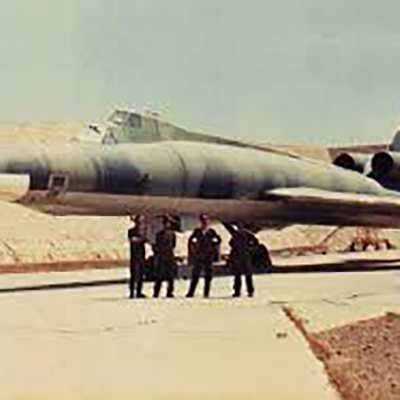Warfare
Tupolev
Mohsen Shir-Muhammad
12 Views
The Tupolev bomber, produced by the former Soviet Union in Tu-16 and Tu-22 models, was employed by the Iraqi Air Force during the imposed war against Iran to attack both military and civilian targets. The Tu-16 bomber, known as “Badger”, made its first test flight in 1952 and entered operational service in 1954.[1] A reconnaissance version equipped for maritime patrol and exploration missions was also developed.[2] The Tu-16 is about 36 meters long, has a wingspan of roughly 32 meters, and a height of 14 meters. Moreover, it could reach a maximum speed of 992 km/h, a service ceiling of approximately 40000 feet, and a range of 5900 kilometers. It was also capable of carrying up to 9000 kilograms of ammunition.[3] The Tu-22 bomber, known as the “Blinder”, made its first test flight in 1961 and officially entered service in 1963. It was the Soviet Union’s first supersonic bomber capable of aerial refueling.[4] A specialized reconnaissance model was employed for detecting and identifying maritime targets.[5] The Blinder is about 40.5 meters long, has a wingspan of 23.7 meters, and a height of 10.6 meters. It could reach a maximum speed of Mach 1.4, a service ceiling of 60000 feet, and a range of 6500 km.[6] Blinder can carry up to 8000 kilograms of ammunition.[7]
Iraq acquired the Tu-16 bombers in 1961,[8] and the Tu-22s entered service with the Iraqi Air Force in 1974.[9] The first combat mission of the Tu-22 took place that same year, targeting dissident Kurdish forces in Iraq.
Before invading Iran, Iraq had possessed eight Tu-16s and fourteen Tu-22s.[10] These bombers relied on Soviet advisors for technical and logistical support.[11] On the first day of Iraq’s full-scale invasion of Iran (September 22, 1980), four Tu-22s attacked Mehrabad International Airport and the 1st Tactical Fighter Base, destroying two military aircraft and damaging three transport planes as well as several hangars.[12] Two other Tu-22s struck Shiraz Airport, and three Tu-16s attempted to bomb Isfahan,[13] of which one was shot down near Ilam by Iranian air defenses, and all crew members were killed.[14]
On October 29, 1980, two Tupolev Tu-22 aircraft entered Iranian airspace in an attempt to bomb Isfahan and Tehran. However, one of them crashed near Najafabad, Isfahan, after colliding with high-voltage power lines, while the other was shot down by air defense units stationed at Manzariyeh Garrison in Qom.[15]
During Operation Valfajr 8 in February 1986, Tu-16 and Tu-22 bombers were deployed to strike Iranian positions. On February 16, 1986, an Iranian Hawk missile site stationed in Abadan[16] shot down a Tu-22.[17]
As the Iran–Iraq War went on, Tu-16 and Tu-22 aircraft were equipped with Soviet-made AS-6 anti-ship missiles.[18] Iraq also acquired heavy bombs for the Tu-16 bombers (Soviet-made), each weighing approximately 9000 kilograms and carrying a TNT equivalent of 4000 kilograms.[19]
Overall, in conventional operations, the payload capacity and accuracy of Tu-22s were not significantly different from those of other modern fighter-bombers. However, Tu-16s were so vulnerable that the Iraqi Air Force rarely used them for deep-penetration missions.[20]
In 1987, the Iraqi Air Force purchased four B-6 bombers (the Chinese version of the Tu-16) along with thirty to fifty C-601 Silkworm air-launched anti-ship missiles from China,[21] to target Iran’s oil tanker fleet and merchant vessels.[22] On February 5, 1988, in Iraq’s first attack using the C-601, the Iranian ship Iran Entekhab was hit.[23] In total, 14 Iranian oil tankers were targeted with C-601 missiles launched from B-6 aircraft.[24]
Over the eight years of the Iran–Iraq War, four Tu-22 Blinders were destroyed by Iranian Tomcats (F-14s) and Hawk missiles, and three Tu-16 bombers were brought down by Rapier surface-to-air missiles. Three more were severely damaged but managed to make emergency landings in Iraq.[25]
[1] Namazi, Mahmoud va Digaran, Havapeyma-shenasi (Studying the Aircraft), Tehran, Chapkhane-ye Niroo-ye Havaei Artesh, 1371, p. 252.
[2] Ibid., p. 253.
[3] Ibid., Pp. 254–255.
[4] Ibid., p. 257.
[5] Ibid., p. 258.
[6] Ibid., p. 259.
[7] Ibid., p. 260.
[8] Babamuhammadi, Mahdi, Dastan-e Yek Canopy, Bakhsh-e Dovom (Story of a Canopy, Part Two), Mahname-ye Sanaye Havaei, No. 241, Mordad va Shahrivar 1390, p. 13.
[9] Babamuhammadi, Mahdi, Hasht Sal-e Jang-e Tahmili dar Aseman, Bakhsh-e Sizdahom (Eight Years of the Imposed War in the Sky, Part Thirteen), Mahname-ye Sanaye Havaei, No. 242, Mehr 1390, p. 23.
[10] Tarikh-e Nabardhaye Havaei Defa Muqaddas, Vol. 1: Ta Aghaz-e Tahajom-e Sarasari (History of Air Battles in Sacred Defense, Vol. 1: Until the Start of the All-Scale Invasion), Tehran, Markaz-e Entesharat-e Rahbordi-ye NAHAJA, 1st ed., 1393, p. 333.
[11] Babamuhammadi, Mahdi, Dastan-e Yek Canopy, Bakhsh-e Sevom (Story of a Canopy, Part Three), Mahname-ye Sanaye Havaei, No. 242, Mehr 1390, p. 46.
[12] Heyat-e Tadvin-e Tarikh-e Defa Muqaddas, Taqvim-e Mostanad-e Amalkard-e Niroo-ye Elahi-ye Havaei Artesh Jomhuri-ye Eslami-ye Iran, No. 3, Mehr 1359, Tehran, Markaz-e Entesharat-e Rahbordi-ye NAHAJA, 1397, Pp. 10, 11.
[13] Torabi, Majid, Mirajhaye Araqi dar Nabard: Bakhsh-e Sevom (Iraqi Mirages in Battle: Part Three), Mahname-ye Sanaye Havaei, No. 327, Farvardin 1399, p. 41.
[14] Al-Samerraei, Wafiq, Viraneh Darvazeh Sharqi (Ruins of the Eastern Gate), Translator: Adnan Qaruni, Tehran, Markaz-e Farhangi Sepah, 1377, p. 57.
[15] Mousavi, Esmail va Digaran, Taqvim-e Mostanad-e Amalkard-e Niroo-ye Elahi-ye Havaei Artesh Jomhuri-ye Eslami-ye Iran, Vol. 4, Aban 1359, Tehran, Markaz-e Entesharat-e Rahbordi-ye NAHAJA, 1397, Pp. 104, 105.
[16] Zahedi Motlaq, Ebrahim, Shelik be Aseman (Shooting at the Sky), Tehran, Soreh Mehr, 1396, Pp. 209–213.
[17] Ibid., p. 397.
[18] Babamuhammadi, Mahdi, Dastan-e Yek Canopy, Bakhsh-e Chaharom (Story of a Canopy, Part Four), Mahname-ye Sanaye Havaei, No. 243, Aban 1390, p. 20.
[19] Cordesman, Anthony va Abraham Wagner, Dars-haye Jang-e Modern: Jang-e Iran va Araq (Lessons of Modern War: Iran-Iraq War), Translator: Hussain Yekta, Vol. 2, Tehran, Nashr-e Marz-o-Boom, 1390, p. 512.
[20] Ibid., Pp. 407–408.
[21] Babamuhammadi, Mahdi, Dastan-e Yek Canopy, Bakhsh-e Chaharom (Story of a Canopy, Part Four), p. 21.
[22] Navias, Martin S. & E.R. Hooton, Jang-e Naft-kesh-ha (The Tanker War), Translator: Pejman Pourjabari va Rahmat Qara, Tehran, Bonyad Hefz-e Asar va Arzesh-ha-ye Defa Muqaddas, 1392, p. 312.
[23] Ibid., p. 315.
[24] Ibid., Pp. 315–316.
[25] Babamuhammadi, Mahdi, Dastan-e Yek Canopy, Bakhsh-e Chaharom (Story of a Canopy, Part Four), p. 22.





